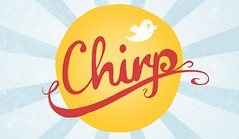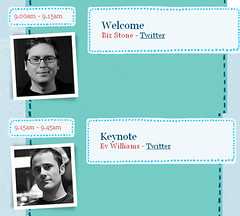Rising infertility concerns fuel growth of male-focused innovative startups
Fertility treatments are more relevant than ever; here are a few startups pioneering new solutions
Read more... Twitter is suddenly more all over the news than
usual. So what’s all buzz?
Twitter is suddenly more all over the news than
usual. So what’s all buzz?
Turns out, lot’s of things.
First, let’s start with the big event: today was the first day of Twitter’s inaugural developers’ conference called Chirp. This is a gathering of just under 100 geeks at San Francisco’s Palace of Fine Arts who build applications that rely on Twitter feeds (or APIs) to provide a Twitter-related service to end-users (that would be you and me.) Company co-Founder and CEO, Evan Williams said that developers using the Twitter API make about three billion calls a day into the service.
These applications make it easier for individuals and businesses to, for instance, send tweets from their desktops or mobile devices across multiple accounts (Seesmic or TweetDeck), or to send pictures via Twitter (TwitPic), or to analyze how well you or your brand is doing in the Twitterverse.
Second, a bunch of numbers were announced today. Company co-Founder
Biz Stone said Twitter now has  nearly 106 million registered users and
adds about 300,000 new users per day worldwide. So, that’s a lot.
What’s really notable is that about 75 percent of Twitter’s traffic is
from outside Twitter.com – that is, all those applications I mentioned
above are driving the lion’s share of tweets that are broadcast around
the world every day. The other big number is that Twitter handles about
19 billion search queries per month either on its own site or via the
API – which makes them second only to Google in total search queries per
month.
nearly 106 million registered users and
adds about 300,000 new users per day worldwide. So, that’s a lot.
What’s really notable is that about 75 percent of Twitter’s traffic is
from outside Twitter.com – that is, all those applications I mentioned
above are driving the lion’s share of tweets that are broadcast around
the world every day. The other big number is that Twitter handles about
19 billion search queries per month either on its own site or via the
API – which makes them second only to Google in total search queries per
month.
That takes us to the third thing: revenue. Since it broadcast its first tweet in March, 2006 everyone has wondered one thing: how will Twitter make money? Four years later, they’ve got an answer. Promoted Tweets.
According to Twitter COO, Dick Costolo, Promoted Tweets will be a system whereby businesses can bid to promote their own tweets into top-of-stream conversations around particular topics. For instance, say you’re Paramount Pictures and you’re promoting a new movie with opening night parties in cities around the U.S. So you blast out tweets saying “Find an opening night party at a theater near you.” Today, you send that tweet out and it quickly becomes buried under all the tweets that follow it. With Promoted Tweets, each time someone includes your keyword – say, the movie’s title, or the name of its principal star – your tweet will quickly follow-on that tweet to the same group of followers. If Paramount’s tweet gets re-tweeted, clicked-on or favorited, such actions will somehow accrue to the benefit of the advertiser (it isn’t exactly clear how, but I’m guessing its akin to Google’s performance-based quality score for ads in its AdWords system).
“All that exist in our monetization platform are tweets,” Costolo said. “Everything is a tweet. A Promoted Tweet is a tweet. You can do anything to a Promoted Tweet that you can do to a regular tweet.”
Pretty cool. Especially for those of us in the advertising and marketing world looking for ways to appropriately engage in the twitterverse without looking pushy or like we’re trying to interrupt something. Bidding on search keywords became Google’s cash cow; it’s clear Twitter is hoping that bidding on keywords in tweets could become a big cash generator for them.
Speaking of money, the fourth big thing is that Twitter is now developing features and functions within its own sphere that will compete directly with some of the applications built by the very third-party developers Twitter is hosting this week at Chirp. As you might imagine, this is profoundly anxiety-producing for start-ups who’ve built their whole business model around the Twitter API and features that heretofore were absent from the core Twitter offering. So there are more than a few geeks sweating over this. Still, Twitter’s new monetization scheme is something they’re willing to share with Twitter developers who build Promoted Tweets into their applications – in fact, they’ve proposed a generous 50 / 50 split for advertising revenue. So, bad news and good news for developers.
Which leads to the last big announcements relating to Twitter this week:
- Google announced that it will make the entire Twitter archive available via its search engine in the coming weeks.
- Microsoft’s Bing announced that it will now elevate relevant tweets in its search results based on real-time trending data.
- Google has also announced that it is incorporating Twitter’s “@anywhere” API, which Twitter announced last month and which makes it easier for third-party websites to incorporate Twitter functionality, into Google’s new service Follow Finder. Just enter your Twitter handle and Follow Finder will recommend other Twitter members who are not yet in your “following” list.
- The U.S. Library of Congress will now officially archive the entire Twitter archive dating back to its opening day in March 2006. Now anything you may have tweeted during that time – and I mean anything – is now resident in the august chambers of our nation’s most prestigious library. Horrifying, no?
Twitter’s impact on the social and cultural landscape worldwide is, presently, incalculable, and it's clear the young company isn’t content to rest on its laurels. These changes, together with the exciting new apps still yet to emerge from its ecosystem of developers, portends more exciting announcements to come.
Fertility treatments are more relevant than ever; here are a few startups pioneering new solutions
Read more...After a trial in select locations, Elon Musk is expanding its fee to more X users
Read more...The tools include content such as educational videos, recipes, and daily nutrition tips
Read more...Startup/Business
Joined Vator on
People share their opinion on any topic in video. There is a social software layer, much like Twitter, to follow the conversation. Loic calls it the "CNN of my friends."
There are 2,000 videos posted per day with only 1,500 people subscribed to the stealth site.
Startup/Business
Joined Vator on
Yield Software's complete Yield Web Marketing Suite for Business and for Agencies includes a Paid Search Optimizer for management of PPC campaigns; Natural Search Optimizer for improved SEO and page rank; and Landing Page Optimizer, which includes a multivariate test engine to ensure landing pages are converting as well as possible. Our system enables businesses of all sizes and growing agencies to fully embrace the potential of search marketing across Google, Bing and Yahoo! All of which leads to increased traffic to websites at a lower overall cost, resulting in greater conversion rates and increasing revenues. Try a free 15-day trial or learn more at www.yieldsoftware.com.Startup/Business
Joined Vator on
Twitter is an online information network that allows anyone with an account to post 140 character messages, called tweets. It is free to sign up. Users then follow other accounts which they are interested in, and view the tweets of everyone they follow in their "timeline." Most Twitter accounts are public, where one does not need to approve a request to follow, or need to follow back. This makes Twitter a powerful "one to many" broadcast platform where individuals, companies or organizations can reach millions of followers with a single message. Twitter is accessible from Twitter.com, our mobile website, SMS, our mobile apps for iPhone, Android, Blackberry, our iPad application, or 3rd party clients built by outside developers using our API. Twitter accounts can also be private, where the owner must approve follower requests.
Twitter started as an internal project within the podcasting company Odeo. Jack Dorsey, and engineer, had long been interested in status updates. Jack developed the idea, along with Biz Stone, and the first prototype was built in two weeks in March 2006 and launched publicly in August of 2006. The service grew popular very quickly and it soon made sense for Twitter to move outside of Odea. In May 2007, Twitter Inc was founded.
Our engineering team works with a web application framework called Ruby on Rails. We all work on Apple computers except for testing purposes.
We built Twitter using Ruby on Rails because it allows us to work quickly and easily--our team likes to deploy features and changes multiple times per day. Rails provides skeleton code frameworks so we don't have to re-invent the wheel every time we want to add something simple like a sign in form or a picture upload feature.
There are a few ways that Twitter makes money. We have licensing deals in place with Google, Yahoo!, and Microsoft's Bing to give them access to the "firehose" - a stream of tweets so that they can more easily incorporate those tweets into their search results.
In Summer 2010, we launched our Promoted Tweets product. Promoted Tweets are a special kind of tweet which appear at the top of search results within Twitter.com, if a company has bid on that keyword. Unlike search results in search engines, Promoted Tweets are normal tweets from a business, so they are as interactive as any other tweet - you can @reply, favorite or retweet a Promoted Tweet.
At the same time, we launched Promoted Trends, where companies can place a trend (clearly marked Promoted) within Twitter's Trending Topics. These are especially effective for upcoming launches, like a movie or album release.
Lastly, we started a Twitter account called @earlybird where we partner with other companies to provide users with a special, short-term deal. For example, we partnered with Virgin America for a special day of fares on Virginamerica.com that were only accessible through the link in the @earlybird tweet.
What's next for Twitter?
We continue to focus on building a product that provides value for users.
We're building Twitter, Inc into a successful, revenue-generating company that attracts world-class talent with an inspiring culture and attitude towards doing business.

Joined Vator on